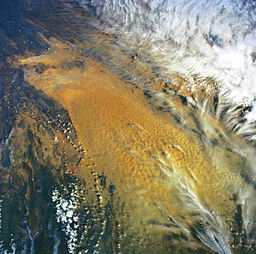Lop Desert
| Lop Desert | |
| Desert | |
|
Satellite picture of the Lop Desert with the basin of the formerly sea Lop Nur. In the left Kuruk-tagh, in the right Astin-tagh.
|
|
| Country | China |
|---|---|
| Chinese Region | Xinjiang |
| Area | 50,000 km2 (19,305 sq mi) |
The Lop Desert, or the Lop Depression, is a desert extending from Korla eastwards along the foot of the Kuruk-tagh (meaning Dry Mountain) to the formerly terminal Tarim Basin in the Xinjiang Uyghur Autonomous Region of China. It is an almost perfectly flat expanse with no topographic relief. Lake Bosten in the northwest lies at an altitude of 1,030 m to 1,040 m (3,380 to 3,410 ft), while the Lop Nur in the southeast is only 250 m lower.
The Lop Desert is on the whole flat, but with three slightly more depressed areas which might form lakes if filled with water - the Lop Nor dried basin, Kara-Koshun dried basin and the Taitema Lake basin. These formed, at one time or another, the terminal lakes of the Tarim-Konque-Qarqan river system. The Tarim River changes its course through time, and therefore the location of the terminal lake also changes, causing some confusion amongst the early explorers as to the exact location of Lop Nor, and the lake was thus referred to as the "Wandering Lake."
In the past Lop Nur was a huge marsh in the eastern part of Xinjiang. Now the region is a broad, unbroken expanse of clay intermingled with sand. The clay, mostly of a yellow or yellow-grey color, is hard and thickly sprinkled with fine gravel. There are benches, flattened ridges and tabular masses of consolidated clay (yardangs) that are in a distinctly defined laminae, three stories being sometimes superimposed one upon the other, while their vertical faces are abraded, and often undercut, by the wind. The formations themselves are separated by parallel gullies or wind furrows, 6 to 20 feet deep, all sculptured in the direction of the prevailing northeast to southwest wind. There is no drifting sand or sand dunes, except in the south towards the outlying foothills of the Altyn-Tagh.
The climate of Lop Desert is extremely arid, a study in 1984 gives a mean annual precipitation of generally less than 20 mm, in another study in 2008 it was recorded as 31.2 mm. In the depression centre below 800 m in elevation, aridity can be expected to be much more extreme. Relative humidity of the atmosphere frequently dropped to zero, with air temperature as high as 50 °C. Annual evaporation was estimated in 1984 to be between 1,000 and 1,500 mm in 1984, meaning that a lake with about 2 m in water depth will dry out within less than two years if cut off entirely from its feeding source. In 2008 the annual evaporation was reported as 2,901 mm.
...
Wikipedia

